“Ullambana” Festival
0
“Ullambana” Festival by Bukit Timah Seu Teck Sean Tong @ Tangling Halt.
by Sugen Raniah
The Ullambana Festival is observed and celebrated by the Buddhists during the Seventh Lunar Month. The Sanskrit term, ‘Ullambana’, refers to the compassion for all beings suffering in the realms of misery. The observance of this festival is based on a discourse by the Buddha – where Maudgalyayana, a disciple of the Buddha, discovers that his mother, Lady Niladhi, had been reborn into the realms of misery. The troubled Maudgalyayana then seeks the Buddha for help. The Buddha advises him to make offerings to the Sangha, as the merit of doing so would help relieve the suffering of his Mother, and that of other beings in the same state.
Here in Singapore, it is a common sight for Teochew sian t’ngs (temples) to perform these rituals during the seventh lunar month. I observed and documented the Ullamabana Festival at Tanglin Halt Market and Hawker Centre by the members of Bukit Timah Seu Teck Sean Tong.
There are three temporary ceremonial altars set up in the tentage – the main altar of the three Buddhas, the altar for the Patron Deity, Du Di Gong and the last for Da Shi Ye (King of Ghosts). Offerings of dried goods and drinks, vegetables, a variety of meat and paper offerings are assembled in the centre of the tentage. Here associate members of the market and members of public are invited to offer joss sticks to the wandering spirits. There are also smaller areas around designated for the spirits for ‘lodging’, ‘washroom’ and ‘leisure’ purposes.
Unlike the elaborate Taoist salvation rituals by Xuan Jian Dian, the Buddhists embrace the recital of Ulka Mukha Sutra. Men, draped in red vestments, are represented as the Sangha (the community of disciples). The Sutra recited is an amalgamation of the mind, body and mouth. Mind in absolute contemplation, with hand gestures of the mystical Mudras and together with the recitation of esoteric words of the Sutras- they invite the wandering spirits to listen to the teachings of Buddha and liberate them from all sufferings. These men sing the Sutra in Teochew and the lyrics are accompanied by beautiful Teochew styled music. It is meant to work like a beautiful charm that draws the spirits to listen and attain liberation.

The ‘Sanghas’ paying homage to the Patron Deity of the market and hawker centre – Du Di Gong (photo Sugen Ramiah)
The day ritual comes to a close with the tossing of longevity buns. The food offerings are then packed and distributed to contributors and friends. Members of the temple take a break before preparing for the dance of the auspicious lanterns later in the evening.
****
Sugen Ramiah a teacher by training, has been observing and documenting Chinese festivals and rituals conducted by temples for the past one and half years.
More on the Hungry Ghost Month from Sugen here and here .
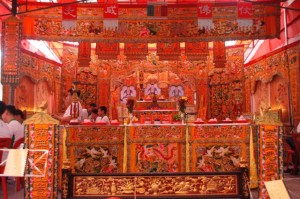
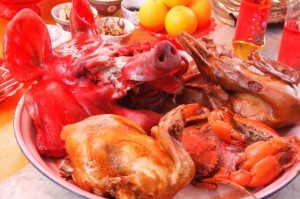

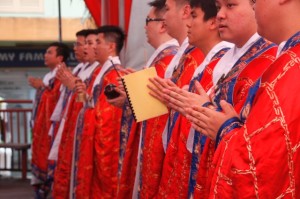
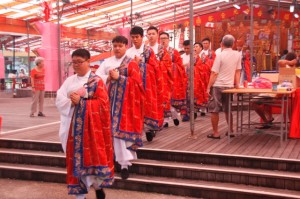
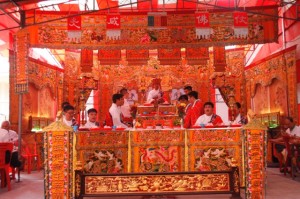

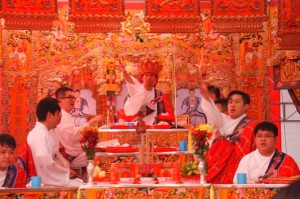
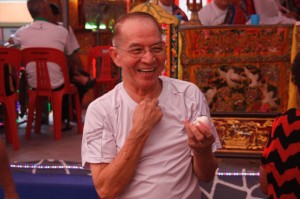

Comments